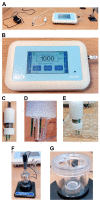In Vitro Methods for Measuring the Permeability of Cell Monolayers
- PMID: 35200533
- PMCID: PMC8874757
- DOI: 10.3390/mps5010017
In Vitro Methods for Measuring the Permeability of Cell Monolayers
Abstract
Cell monolayers, including endothelial and epithelial cells, play crucial roles in regulating the transport of biomolecules to underlying tissues and structures via intercellular junctions. Moreover, the monolayers form a semipermeable barrier across which leukocyte transmigration is tightly regulated. The inflammatory cytokines can disrupt the epithelial and endothelial permeability, thus the reduced barrier integrity is a hallmark of epithelial and endothelial dysfunction related with numerous pathological conditions, including cancer-related inflammation. Therefore, the assessment of barrier function is critical in in vitro models of barrier-forming tissues. This review summarizes the commercially available in vitro systems used to measure the permeability of cellular monolayers. The presented techniques are separated in two large groups: macromolecular tracer flux assays, and electrical impedance measurement-based permeability assays. The presented techniques are briefly described and compared.
Keywords: dysfunction; endothelium; epithelium; fluorescent tracer; microfluidics; permeability; transendothelial resistance.
Conflict of interest statement
The authors declare no conflict of interest.
Figures



Similar articles
-
Characteristics of the low density corneal endothelial monolayer.Exp Eye Res. 2013 Oct;115:239-45. doi: 10.1016/j.exer.2013.06.024. Epub 2013 Jul 3. Exp Eye Res. 2013. PMID: 23830909
-
Erratum: Scalable Fabrication of Stretchable, Dual Channel, Microfluidic Organ Chips.J Vis Exp. 2019 May 8;(147). doi: 10.3791/6296. J Vis Exp. 2019. PMID: 31067212
-
Comparison of the function of the tight junctions of endothelial cells and epithelial cells in regulating the movement of electrolytes and macromolecules across the cell monolayer.J Cell Physiol. 1990 Sep;144(3):498-504. doi: 10.1002/jcp.1041440318. J Cell Physiol. 1990. PMID: 2391379
-
Structural pathways for macromolecular and cellular transport across the blood-brain barrier during inflammatory conditions. Review.Histol Histopathol. 2004 Apr;19(2):535-64. doi: 10.14670/HH-19.535. Histol Histopathol. 2004. PMID: 15024715 Review.
-
The Role of Tricellular Junctions in the Transport of Macromolecules Across Endothelium.Cardiovasc Eng Technol. 2021 Feb;12(1):101-113. doi: 10.1007/s13239-020-00483-x. Epub 2020 Aug 20. Cardiovasc Eng Technol. 2021. PMID: 32820467 Free PMC article. Review.
Cited by
-
GAL3ST1 Deficiency Reduces Epithelial-Mesenchymal Transition and Tumorigenic Capacity in a Cholangiocarcinoma Cell Line.Int J Mol Sci. 2024 Jul 2;25(13):7279. doi: 10.3390/ijms25137279. Int J Mol Sci. 2024. PMID: 39000386 Free PMC article.
-
Protective Effect of Limosilactobacillus fermentum ME-3 against the Increase in Paracellular Permeability Induced by Chemotherapy or Inflammatory Conditions in Caco-2 Cell Models.Int J Mol Sci. 2023 Mar 25;24(7):6225. doi: 10.3390/ijms24076225. Int J Mol Sci. 2023. PMID: 37047193 Free PMC article.
-
Magneto-Mechanical Actuation Induces Endothelial Permeability.ACS Biomater Sci Eng. 2023 Dec 11;9(12):6902-6914. doi: 10.1021/acsbiomaterials.3c01571. Epub 2023 Nov 28. ACS Biomater Sci Eng. 2023. PMID: 38014849 Free PMC article.
-
Research Models to Mimic Necrotizing Enterocolitis and Inflammatory Bowel Diseases: Focus on Extracellular Vesicles Action.Stem Cells. 2023 Dec 14;41(12):1091-1100. doi: 10.1093/stmcls/sxad068. Stem Cells. 2023. PMID: 37688386 Free PMC article. Review.
-
Modeling the Progression of Placental Transport from Early- to Late-Stage Pregnancy by Tuning Trophoblast Differentiation and Vascularization.Adv Healthc Mater. 2023 Dec;12(32):e2301428. doi: 10.1002/adhm.202301428. Epub 2023 Nov 7. Adv Healthc Mater. 2023. PMID: 37830445 Free PMC article.
References
-
- Martìn-Padura I., Lostaglio S., Schneemann M., Williams L., Romano M., Fruscella P., Panzeri C., Stoppacciaro A., Ruco L., Villa A., et al. Junctional adhesion molecule, a novel member of the immunoglobulin superfamily that distributes at intercellular junctions and modulates monocyte transmigration. J. Cell Biol. 1998;142:117–127. doi: 10.1083/jcb.142.1.117. - DOI - PMC - PubMed
Publication types
LinkOut - more resources
Full Text Sources

